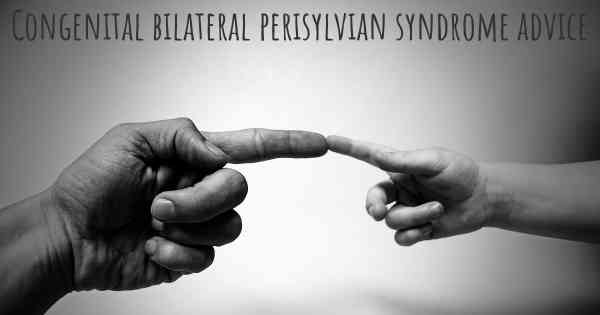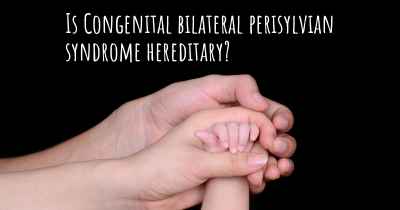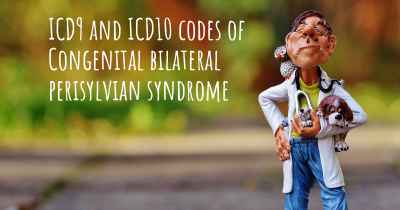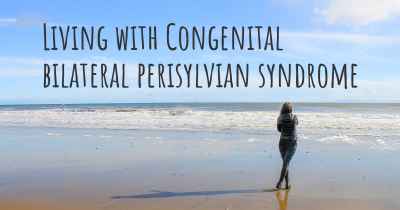Which advice would you give to someone who has just been diagnosed with Congenital bilateral perisylvian syndrome?
See some advice from people with experience in Congenital bilateral perisylvian syndrome to people who have just been diagnosed with Congenital bilateral perisylvian syndrome

Congratulations on taking the first step towards understanding your diagnosis of Congenital Bilateral Perisylvian Syndrome (CBPS). It is important to remember that you are not alone in this journey. CBPS is a rare neurological condition that affects the development of the brain, specifically the perisylvian region. This can lead to various challenges in speech, language, and motor skills. While it may feel overwhelming at first, there are ways to manage and cope with CBPS to lead a fulfilling life.
1. Educate yourself: Knowledge is power, and understanding CBPS is crucial in navigating your way forward. Research reputable sources, consult with medical professionals, and connect with support groups or organizations specializing in CBPS. This will help you gain insights into the condition, its symptoms, potential challenges, and available treatments or therapies.
2. Build a support network: Surround yourself with a strong support system consisting of family, friends, and professionals who can provide emotional support, guidance, and encouragement. They can help you navigate the challenges, celebrate your achievements, and provide a listening ear when needed. Consider joining support groups or online communities where you can connect with individuals facing similar experiences.
3. Seek professional guidance: Consult with a team of medical professionals, including neurologists, speech therapists, occupational therapists, and psychologists who specialize in CBPS. They can assess your specific needs, develop personalized treatment plans, and provide therapies to address speech, language, and motor skill challenges. Regular check-ups and evaluations will help monitor your progress and make necessary adjustments to your treatment plan.
4. Embrace therapy: Speech therapy will play a crucial role in improving your communication skills. Work closely with a speech therapist who understands CBPS and can tailor therapy sessions to your specific needs. They will help you develop strategies to enhance speech production, language comprehension, and social communication. Occupational therapy can also assist in improving motor skills and coordination.
5. Set realistic goals: It is important to set achievable goals and celebrate each milestone along the way. Break down larger goals into smaller, manageable steps to avoid feeling overwhelmed. Remember that progress may be gradual, but every step forward is a victory. Celebrate your achievements, no matter how small, and maintain a positive mindset throughout your journey.
6. Advocate for yourself: Be your own advocate and actively participate in your treatment plan. Communicate openly with your healthcare team, ask questions, and express any concerns or challenges you may face. By actively engaging in your care, you can ensure that your needs are met and receive the best possible support.
7. Explore assistive technologies: Assistive technologies can provide additional support in overcoming communication and motor skill challenges. Investigate options such as augmentative and alternative communication (AAC) devices, speech-to-text software, or adaptive tools that can enhance your independence and quality of life.
8. Practice self-care: Taking care of your physical and emotional well-being is essential. Engage in activities that bring you joy, reduce stress, and promote relaxation. Prioritize self-care routines, maintain a healthy lifestyle, and seek professional help if you experience any mental health concerns. Remember, you are more than your diagnosis, and it is important to nurture your overall well-being.
9. Educate others: Raise awareness about CBPS among your family, friends, and community. Help them understand the challenges you face and how they can support you. By spreading awareness, you can foster a more inclusive and understanding environment for individuals with CBPS and other similar conditions.
10. Stay positive and resilient: While CBPS may present challenges, it does not define your potential or limit your dreams. Stay positive, believe in yourself, and cultivate resilience. Surround yourself with positivity, celebrate your strengths, and remember that you have the ability to overcome obstacles and lead a fulfilling life.
Remember, you are not alone in this journey. Reach out for support, stay informed, and embrace the opportunities for growth and development. With the right resources, guidance, and determination, you can navigate the challenges of CBPS and lead a meaningful life filled with achievements and happiness.
Posted Aug 20, 2017 by Momof2miracles Jess Sundquist 4256








